Beef Tenderloin Roast
Cooking a whole beef tenderloin is actually much easier than you think—and absolutely worth the effort for melt-in-your-mouth filet mignon! I'll walk you through the steps to creating a perfectly roasted beef tenderloin for your next dinner party, holiday meal or Sunday roast.
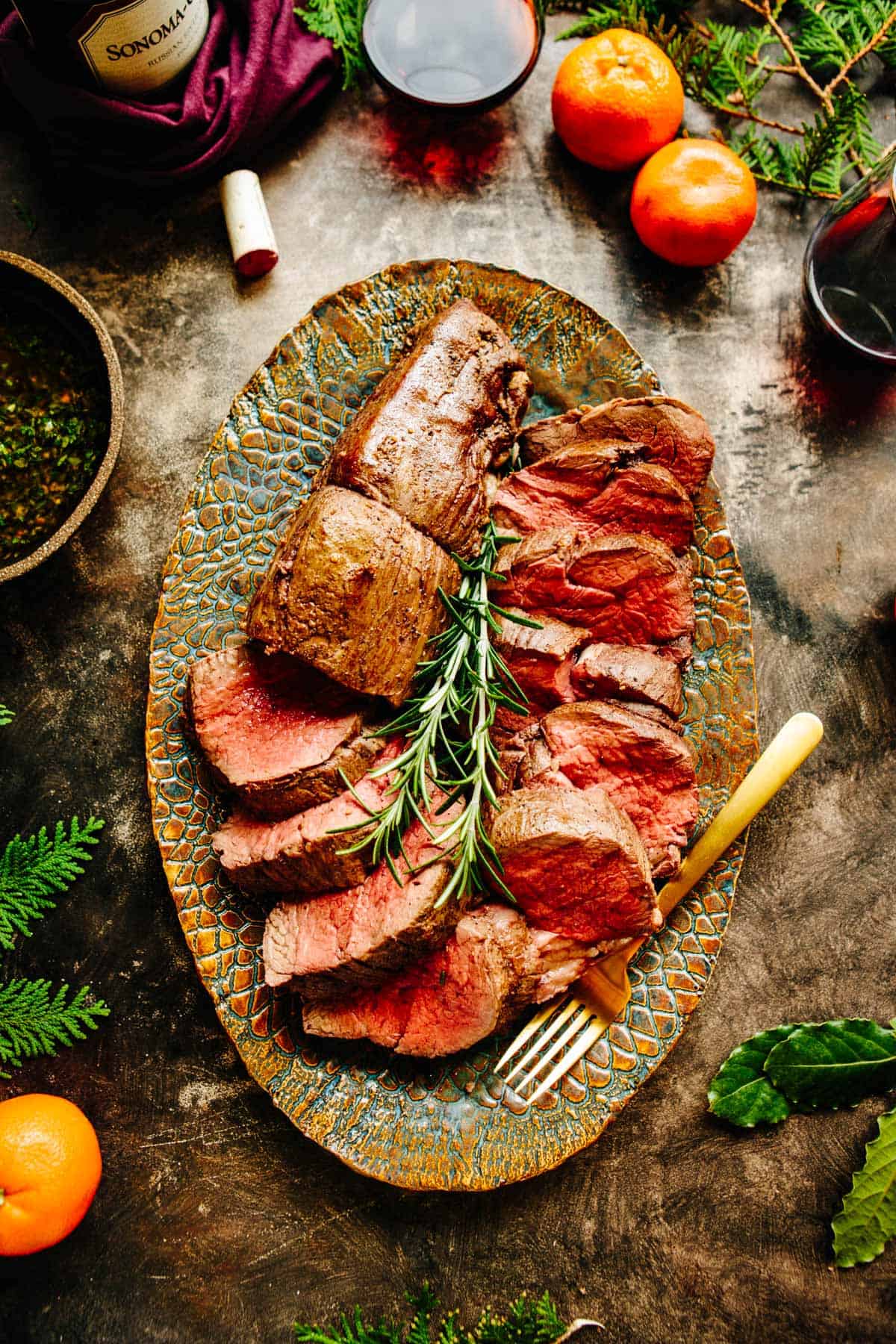
I created this beef tenderloin recipe while working as a private chef. I’ve prepared it hundreds of times and it’s been my tried and true recipe simply because it works.
Beef tenderloin is an expensive cut of meat and you don’t want to mess it up, and my recipe is exactly what you need to make sure you don’t. It utilizes a special technique that’s not only easy, it’s foolproof.
I’m going to break down all of the steps you need to ensure your roasted beef tenderloin, turns out absolutely perfect, every single time.
If you want a roast that’s evenly pink throughout with a nice crust on the outside, keep reading to learn how I use my special reverse sear technique in this straightforward, no-fuss recipe that’s elegant, yet approachable, and always gets rave reviews.
Add homemade jumbo crab cakes or a bowl of lobster bisque to your meal for an incredible 'surf and turf' dinner. Pair it all with a classic French potato gratin, creamed spinach, and a big, bold red wine for a true Steakhouse experience!
What makes this the Best Beef Tenderloin Recipe
- It's more than just a recipe - this extensive guide breaks down everything you need to know to make a perfectly roasted whole beef tenderloin.
- Tender, juicy, and flavorful!
- The "Reverse Sear" technique produces even, juicy results with a great outer crust.
- It's all about temperature, not time, to remove any guesswork.
- Great for a holiday dinner yet simple enough for a low-stress weeknight dinner.
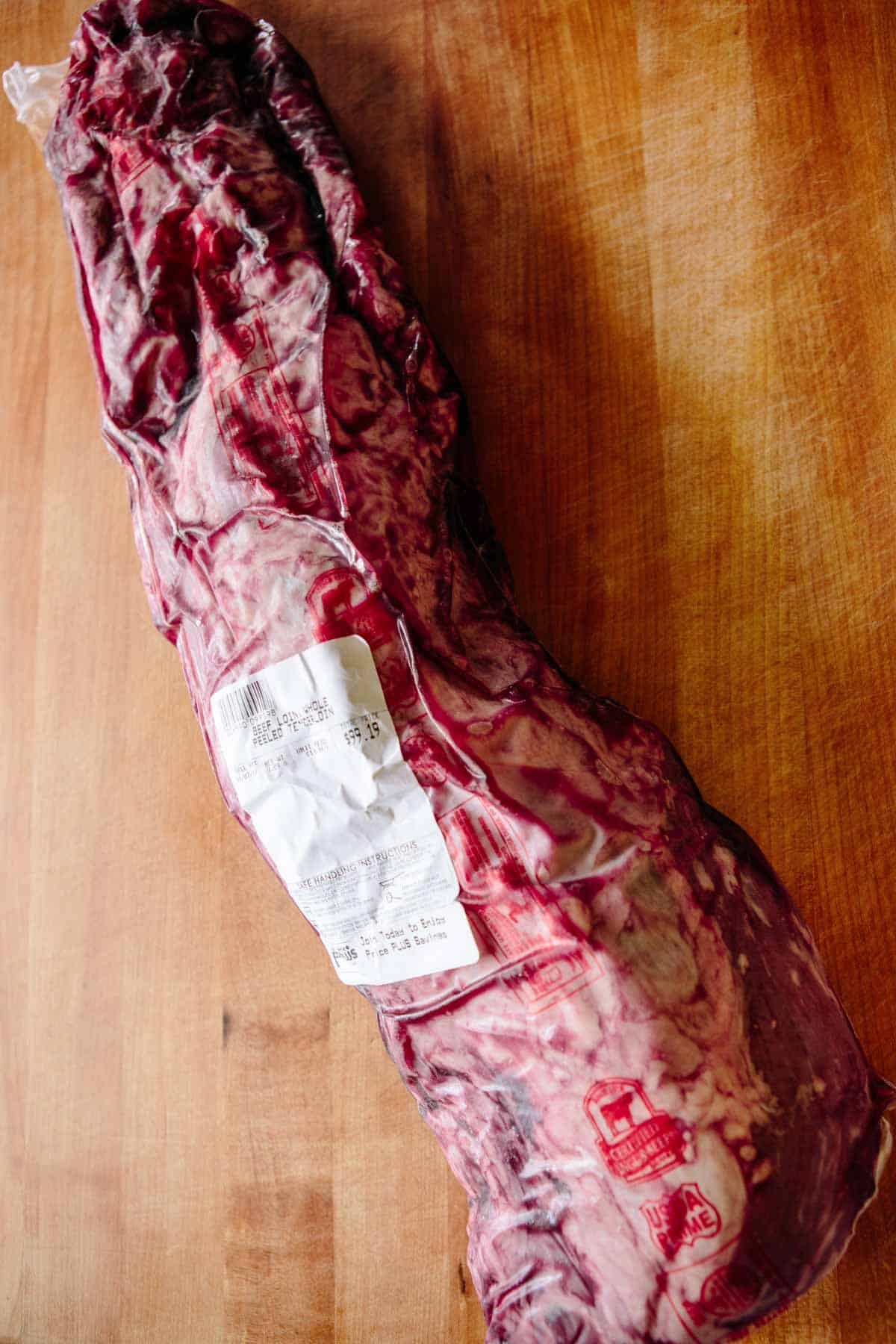
Ingredients for Beef Tenderloin Roast
- Whole Beef Tenderloin: Most grocery stores usually have packaged whole beef tenderloins. If you don't see them on display, just ask your butcher. They might have one in the back, or they can order it for you. The price for a whole tenderloin can vary a lot depending on the size, quality, and when and where you buy it. On average, a whole, untrimmed USDA Choice Angus beef tenderloin costs around $10-$30 per pound. Depending on the type of beef you prefer (grass-fed, organic, or prime), it can cost more. Look for whole tenderloins on sale around the holidays, especially in the days right after. Shoot for about one pound of beef tenderloin per person.
Note: Because of the reverse sear technique, most seasonings other than salt and pepper will burn and taste bitter. Different spices, seasonings, and sauces can be added afterward for more flavor.
Helpful equipment
- Meat Probe Thermometer: One of my favorite and most used kitchen tools. A meat thermometer is essential for making sure your beef tenderloin is perfectly cooked without any guesswork.
- Large Sheet Pan: A whole beef tenderloin is big, so you'll need a big pan to fit it. I use a half sheet pan and usually don't have any problems.
- Butcher's Twine: This is crucial for tying up a beef tenderloin so that it roasts evenly. Butcher's twine has many uses in the kitchen, so I always make sure I have some on hand.
How to cook Beef Tenderloin
Trimming the beef tenderloin
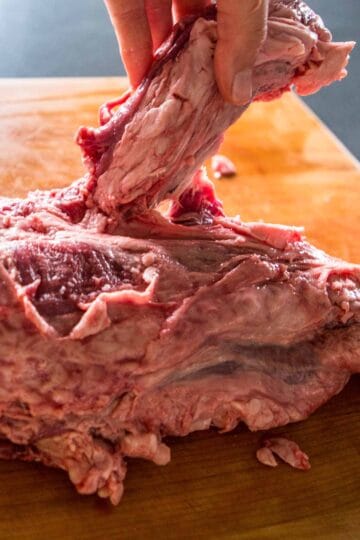
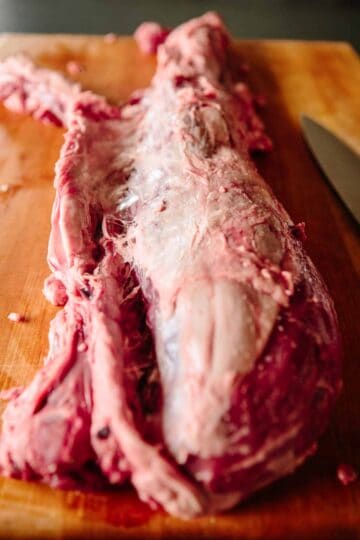
1) Pat the tenderloin dry and remove "the chain." This is a long piece of meat, fat, and connective tissue that runs down the side of the loin. There are two ways you can remove it: Pull it with your fingers or use your sharp Butcher's knife to help you.
2) Next, you'll want to get rid of the silver skin (just like it sounds). Use a super sharp knife for this part. Turn the blade away from you, angle it up a bit, and slice along the very top of the meat, being careful not to take too much of the flesh underneath (you can also trim off the end pieces to make carpaccio).
Tip: A boning or fillet knife works best for this job.
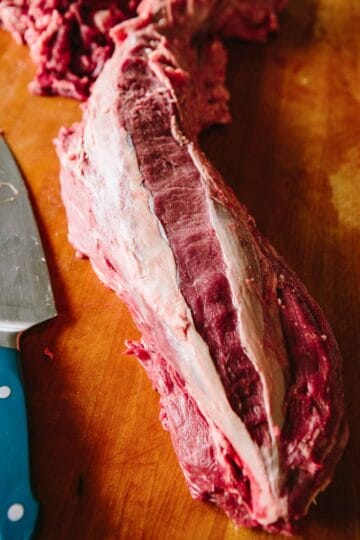
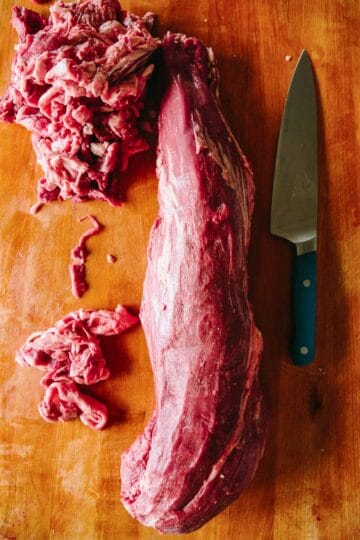
3) For the last step in the prepping process, tie your beef tenderloin up with butcher's twine. Make sure to tie it tight enough to hold the meat together but not so tight that the twine presses into the meat. This keeps the loin nice and compact for even roasting. Repeat every 2-3 inches.
*You can always ask your butcher to prepare the meat for roasting, including grinding up the trimmings. Sometimes they will charge a fee for this, but a lot of the time, they won't (always ask first). Personally, I like to be in control, so I do it myself, but sometimes you just don't have the time or patience, so don't hesitate to ask your butcher to do the heavy lifting. It's their job!
Cooking the beef tenderloin roast
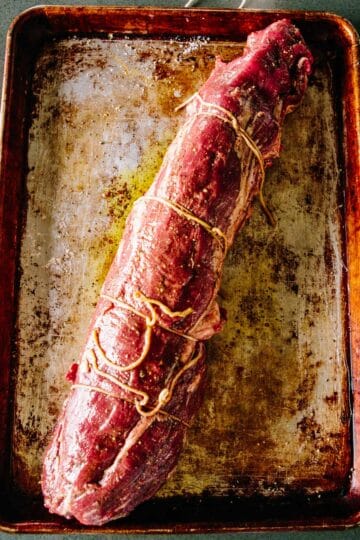
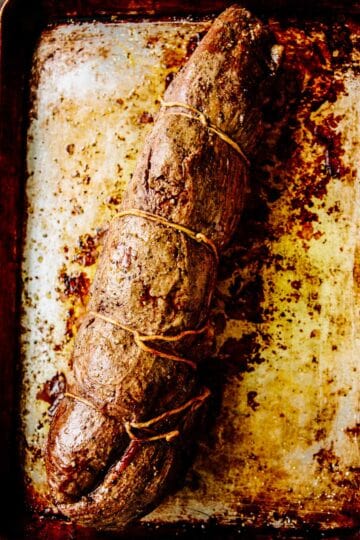
4) Let your meat sit out at room temperature for about an hour before roasting. Meanwhile, go ahead and preheat the oven to 275 degrees F. Once that's done, simply place the loin on a sheet pan, and you're good to go!
5) Rub the beef all over with the olive oil. Then, generously sprinkle and rub all of the sides with kosher salt and freshly ground black pepper.
6) Insert the probe thermometer into the center of the meat. Pop the roast on the middle rack of the oven and cook until it hits your preferred internal temperature (check out the chart below).
7) Remove the probe, then move the pan up to the top rack of the oven and switch on the broiler. Keep a close eye until it's nicely browned on top, for around 30 seconds to a minute, then grab a pair of tongs to give it a quarter turn. Repeat until all 4 sides are browned.
8) Remove from the oven, cover with foil, and let rest for at least 15-20 minutes or longer. Slice and serve as desired.
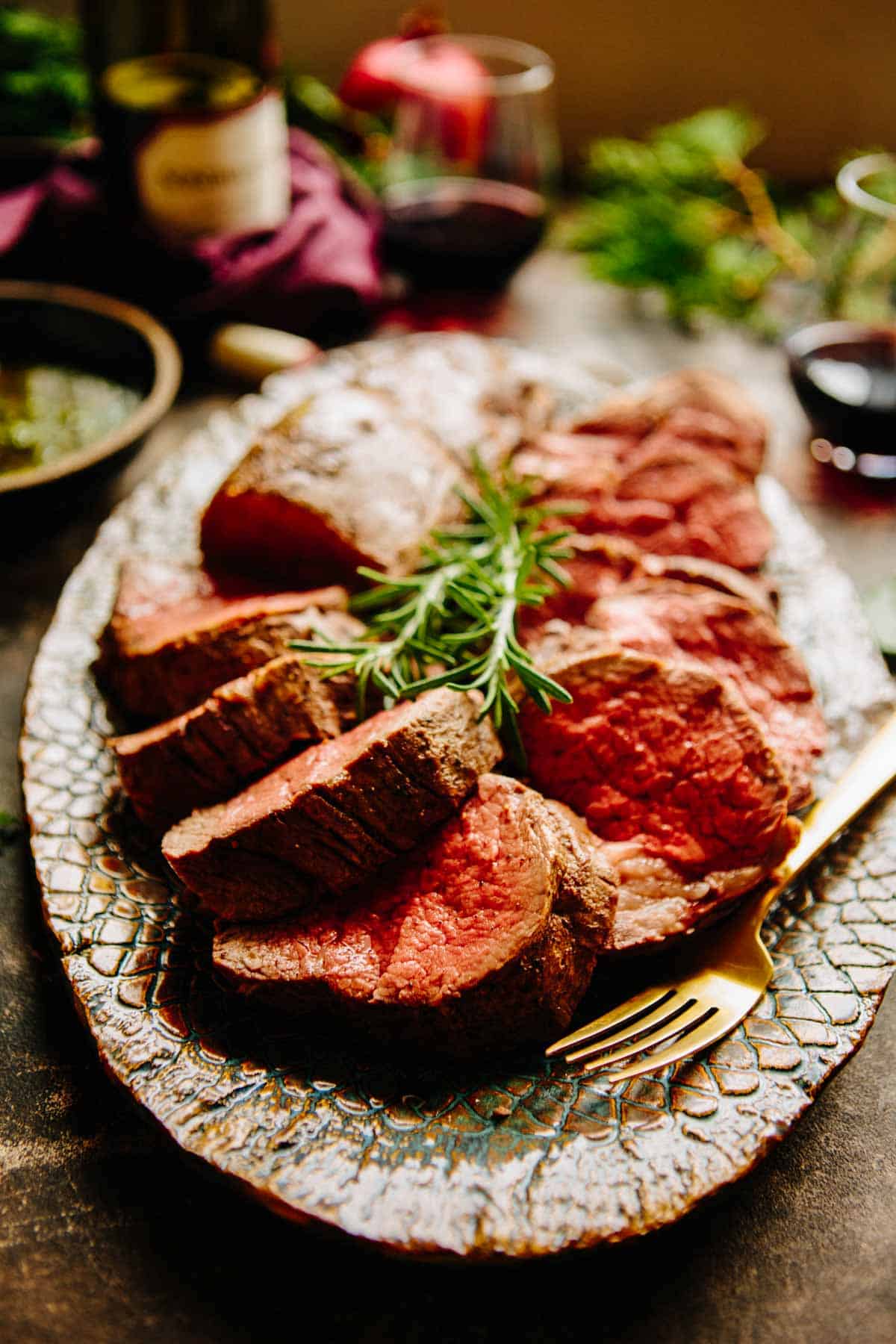
Choose Your Beef Tenderloin Temperature
Use these temperatures as a guideline for cooking a whole beef tenderloin with the reverse sear technique. The numbers are lower than what you'll typically see because they account for the extra cooking during the broiling stage, as well as the carry-over cooking that occurs while the meat rests.
- Rare: 115-120 degrees F
- Medium-Rare: 125-130 degrees F (recommended)
- Medium: 135-140 degrees F
- Medium-Well to Well-Done: 145 degrees F (don't go any higher than this.)
Tips for Making The BEST Beef Tenderloin
- Don't throw away the trimmings from your beef loin! Freeze them in a zip-top bag and use them at a later date (See FAQ for ideas).
- Make sure your meat sits out at room temperature for 30-60 minutes before roasting for even results.
- Do not line your pan with parchment paper, or it will catch on fire when broiling. If you insist on lining your pan, use tin foil.
- Shoot for a medium rare temperature in the center of the roast. The skinnier parts will be more well done, and the fatter parts will be rare, ensuring there is a perfect piece for everyone in your group.
- Be sure to remove the probe thermometer before broiling the meat, otherwise, it could be damaged by the extremely high temperature.
- Never ever skip the resting stage when preparing a whole beef tenderloin. Cutting the meat too soon after cooking will result in dry meat sitting in a puddle of juice. Rest at least 15-20 minutes for juicy meat.
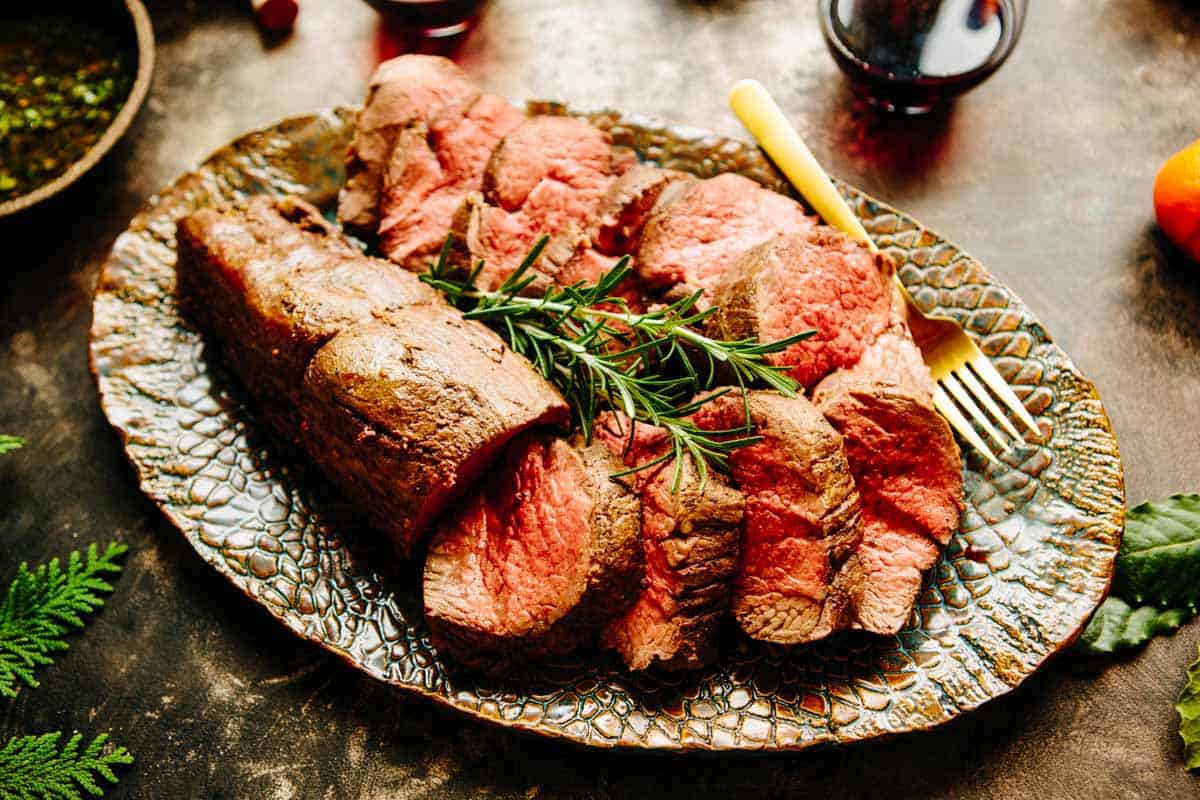
Serving Whole Beef Tenderloin
With the simplicity of this roasted beef tenderloin, the sky is the limit when it comes to putting together the perfect Italian dinner!
- Appetizers: Start with an antipasto of your choice or a simple appetizer like this roasted mushroom crostini with a side of Meyer lemon olives. Pair that with a glass of red wine to enjoy with the rest of your meal. Chianti, Cabernet Sauvignon, or Bordeaux are all nice!
- Salads: Then, kickstart your meal with a tossed salad of your choice, like a kale Caesar salad or a warm spinach salad with pancetta and goat cheese.
- Sides: You can serve a few slices of this beef steak with a delicious potato side dish. You can make these rosemary potatoes and onions or go for a rich potato gratin (or swap it out and make a cauliflower gratin instead). You can also never go wrong with a scoop of creamy mashed potatoes!
- Veggies: Add your favorite veggie side dish as well. My personal go-to's are sauteed broccoli rabe and classic creamed corn for a steakhouse feel. For a traditional Italian flair, consider making this wild mushroom risotto.
And you can't have a juicy piece of beef tenderloin without a delicious sauce to go with it! Some options include a horseradish cream sauce, a red wine bordelaise sauce, chimichurri sauce, or Italian salsa verde. Even just some good old-fashioned steakhouse sauce can do the trick.
Finish off your meal with a decadent chocolate dessert. My chocolate hazelnut panna cotta would pair perfectly with this meal, but you can never go wrong with a classic chocolate chip cookie or a fudgy salted caramel chocolate brownie!
Storing Beef Tenderloin
Store leftover beef tenderloin wrapped tightly in plastic wrap and refrigerated for up to 4 days. Leftovers can be eaten cold or gently reheated to eat warm. Be careful not to heat the beef too much or it can overcook.
This post may contain affiliate links.
FAQS
Tenderloin is a cut of beef that comes from the loin section. It runs along both sides of the spine and is one of the most tender cuts of beef.
While both the tenderloin and filet mignon come from the same part of a cow, they are not exactly the same.
The tenderloin is a long, slender cut of beef that runs along the spine. It's known for its tenderness and is where the filet mignon comes from.
Filet mignon, on the other hand, is a steak usually cut from the narrower end of the tenderloin. It's often cut into thick portions and is regarded as one of the most premium, luxurious, and tender cuts of beef available.
So basically, all filet mignon is beef tenderloin, but not all beef tenderloin is filet mignon!
When selecting a beef tenderloin, look for one with minimal visible fat and consistent thickness throughout. This will ensure even cooking.
For a boneless beef tenderloin, plan on one pound of meat per person if you're serving it as a main course. If it's part of a larger meal with other dishes, you can get away with about ½ pound per person.
One pound of meat may seem like a lot for one person, but the loin will be smaller after trimming and roasting, and it's always better to have leftovers than not having enough.
No, many people choose to leave the tenderloin untrimmed. The upside is that it looks bigger and feeds more folks.
The downside? Your guests have to deal with the fat and connective tissue themselves, tossing those scraps in the trash instead of putting them to good use.
Trimming the meat gives you a smaller loin, but it cooks more evenly and results in round, meaty pieces of steak with nothing to cut off.
I recommend running them through a meat grinder or having your butcher do it for you (I use the KitchenAid Meat Grinder attachment).
The ground beef that you get from this will work great in any recipe you want and will give you a burger that's super juicy, full of flavor, and absolutely delicious.
If you have any extra trimmings, just pop 'em in the freezer and grind them up later.
Pro Tip: Meat is easier to grind when it's partially frozen!
Don't worry about time. If you want consistently good results, just go by temperature.
That being said, plan for around 2-3 hours to trim, roast and rest, but remember that the actual time will depend on the size of your loin.
The u0022reverse searu0022 technique involves cooking meat low and slow initially and then quickly searing it at the end to brown the exterior (in this case, broiling).
It's kind of the opposite of the traditional method where you sear the meat first and then finish cooking it in the oven. Bur the awesome thing about this reverse sear technique is that it makes the meat juicier and evenly cooked throughout while still giving it a nice crust on the outside.
Leftover beef tenderloin is perfect for making sandwiches and a delicious salad. I really enjoy a few slices of the juicy beef with this heirloom tomato salad. The bleu cheese crumbles and fried shallots in the salad go perfectly with the rich and tender beef.
You could also serve the beef tenderloin as a protein in a pasta or risotto dish. I especially enjoy eating it with a generous helping of wild mushroom risotto. The earthiness of the mushrooms and the creaminess of the risotto cut through the richness of the beef for a perfect bite.
And, of course, you can never go wrong with a classic steak and eggs for breakfast (or dinner!). The beef can be a part of an omelet or served with eggs and toast.
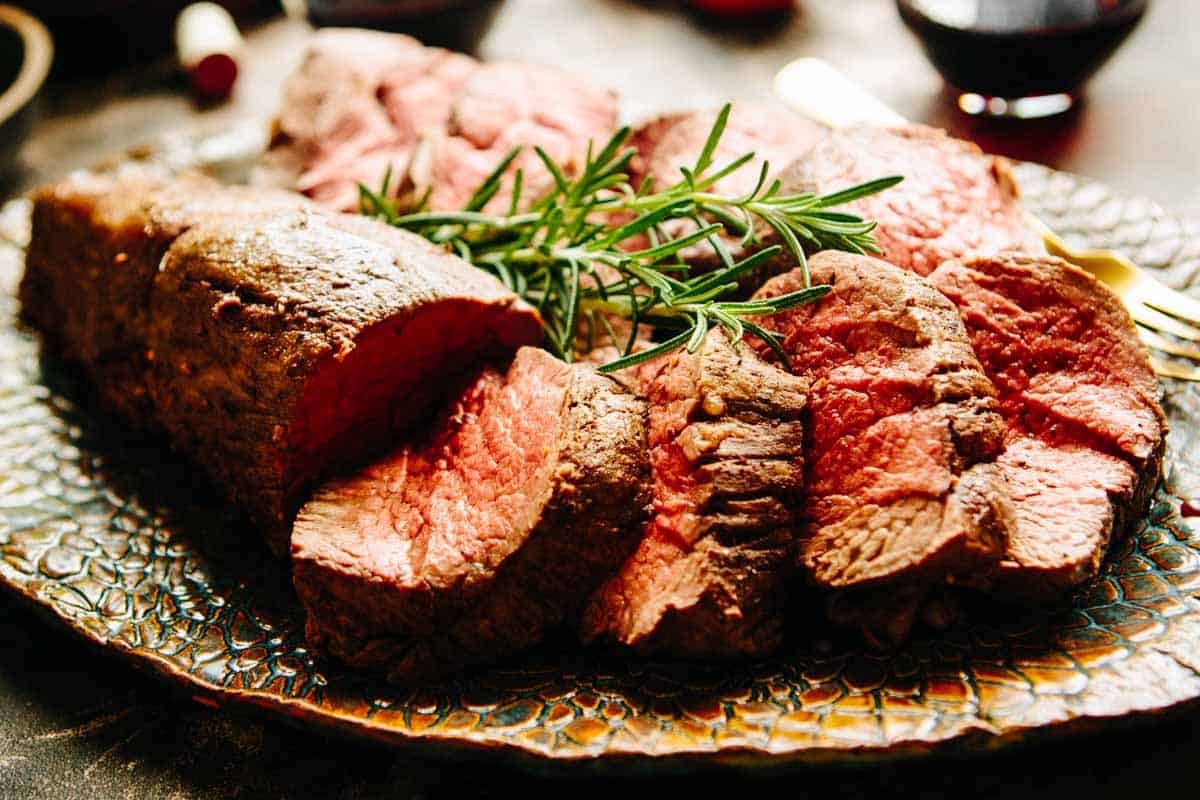
Related recipes
Did you make this recipe and LOVE it? Please leave a star ⭐️ rating and/or comment to help other readers. I absolutely love hearing from you and do my best to answer all questions and comments. I love seeing when you make my recipes, so please tag me @ColeyCooks on Instagram and I will repost!
Want to Save This Recipe?
Enter your email & I'll send it to your inbox.
By submitting this form, you consent to receive emails from Coley Cooks.
Best Beef Tenderloin
Ingredients
- 1 whole beef tenderloin trimmed and tied*
- Olive oil
- Kosher salt
- Freshly cracked black pepper
Instructions
- Let your meat sit out at room temperature for an hour prior to roasting. Preheat the oven to 275 degrees F, then place the loin on a sheet pan.
- Rub all over with olive oil, then rub generously on all sides with kosher salt and freshly cracked black pepper. Insert a probe thermometer into the center of the meat.
- Roast on the center rack of the oven until your desired internal temperature is reached. Rare: 115-120 degrees F. Medium-Rare: 125-130 degrees F (this is what I recommend). Medium: 135-140 degrees F.
- Take out the probe, then move the pan up to the top rack of the oven and turn on the broiler. Keep a close watch until it's nicely browned on top, about 30 seconds to a minute, then use a pair of tongs to turn it ¼ of the way. Repeat until browned on all 4 sides.
- Remove from the oven, cover with foil, and let rest for at least 15-20 minutes or longer.
- Slice and serve as desired.
Notes
- *See post for instructions on trimming and tying, or ask your butcher to do it for you.
- Don't throw away the trimmings! Freeze them in a zip-top bag and use at a later date (See FAQ for ideas).
- Make sure your roast sits out at room temperature for 30-60 minutes before roasting for even results.
- Never ever skip the resting stage. Cutting the meat too soon after cooking will result in dry meat sitting in a puddle of juice. Rest at least 15-20 minutes for juicy meat.
- Shoot for a medium rare temperature in the center of the roast. The skinnier parts will be more well done and the fatter parts will be more rare, ensuring there is a perfect piece for everyone in your group.
- Be sure to remove the probe thermometer before broiling the meat, otherwise it could be damaged by the extreme high heat.
- Never line your pan with parchment paper or it will catch on fire when broiling. If you insist on lining your pan, use tin foil.

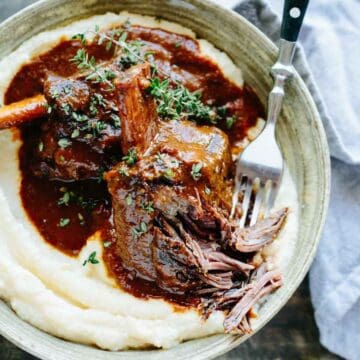

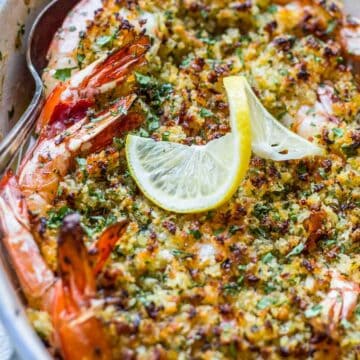
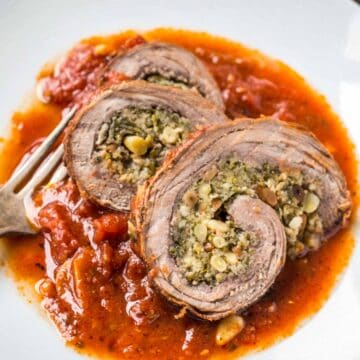
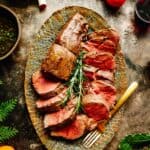




This beef tenderloin recipe is a winner every time! I've made it a bunch of times now, and having a battery-operated meat thermometer has been a total lifesaver. You just stick the probe in the meat before popping it in the oven, and it stays there until it beeps to let you know it's done—so handy! It's super simple to make, but it looks like you really put in a lot of effort. I’m definitely planning to try the Bordelaise sauce next!
I'm so glad you love the recipe! Thank you so much for leaving a review!
My go to quick reminder on how to make a perfect tenderloin. Christmas dinner was a hit and I used some of the scraps for the au jus.
So glad you loved the recipe! Thank you so much for leaving a review!:)
Made this last night as directed for medium rare and it was perfect! Didn’t have a meat thermometer so roasted at 275 (per recipe directions) for 40 minutes and then broiled all sides for about a minute. Let sit for 20 minutes before slicing. I used a 3lb. strip. Thank you for this very yummy and easy preparation..
SO happy you loved the recipe and your steak turned out perfect!
This is a perfect recipe. It’s easy to follow and comes out perfect every time. I love to make it on special occasions.
I doubt you'll see this on Christmas day, but I'm wondering how long to cook a 3lb beef tenderloin to medium? Thank you!
Hi Wendy. Sorry I didn't see your question in time but I hope you were able to find the answer in the FAQ section. Plan for around 2-3 hours to trim, roast and rest the rest, but remember that the actual time will depend on many factors, such as temperature. Always use a thermometer for best results. Hope this helps in the future!
Hello Coley, I am new to this site and love your approach to cooking this roast. Will be doing for a special dinner. I don't see the bordelaise sauce posted on your site, were you just suggesting this type of sauce or do you have a posted recipe somewhere?
Thank you.
I have a recipe but it's not on my site - yet. Here you go! Please let me know if you make it!
Bordelaise Sauce:
* 2 teaspoons olive oil
* 4 large shallots, finely chopped
* salt
* 2 teaspoons flour
* 2 cups dry red wine
* 3 cups beef tenderloin pan juices and beef stock*
* 2 tablespoons unsalted butter
1. Heat olive oil in a large saucepan over medium heat. Add shallots with a pinch of salt, then cook until softened and just starting to turn golden, about 10 minutes.
2. Stir in flour, then whisk in red wine and beef stock. Bring up to a simmer and cook until thickened and reduced by half.
3. Set a fine mesh strainer over another saucepan, then strain the mixture, being sure to press down to extract every last bit of liquid. Taste for seasoning and add more salt and pepper as desired. Whisk in butter, then serve immediately.
I make this every Christmas, and have tried many formats. I tried this one and loved it. This year I need to prepare two tenderloins. Can I do both at the same time?
So glad you love the recipe! Yes, you can definitely do both at the same time. Just be sure to keep track of the internal temperature of each. They may take different amounts of time. Hope this helps!
Excellent recipe.
So glad you enjoyed it!
Came out really good
So glad to hear it!
This was a lot of information to get through but it was really helpful. I was intimidated to cook such an expensive piece of meat but it turned out better than i could have hoped.
So glad you enjoyed it Charlie!
Phenomenal. Made this for a bridal shower and it turned out PERFECT. Your instructions were easy to follow. This will be my new go-to.
So glad it was a success!!
Came out incredible, everyone loved it. thanks for the tips
Incredible recipe. Super informative. My roast turned out perfect, there were no leftovers.
Thank you! So glad you loved it!
This was such a helpful and thorough tutorial. I followed your instructions to a T and the meat came out PERFECT. Such a hit!! Thank you!!
Thank you! SO happy you enjoyed the recipe!
Nicole, I made the beef tenderloin with the Bordelaise sauce for Christmas dinner last night. It was AMAZING! The beef turned out fork tender. I'm saving my trimming pieces for a yummy round of stroganoff, Thank you for the recipe, it is definitely a show stopping keeping!
Coley, you are a great photographer! Love the recipe.
Thanks, Sabine! That means a lot coming from a great photographer such as yourself. Happy New Year! it was great connecting in 2017 😀
Ohhhh MAN!!! It's 9 o'clock in the morning and now I want some of this... NOW! Hehehe! I might try this next time. Usually, I do the whole "grill" thing, but it's such a pain in the winter. Who wants to keep checking the steaks out in the snow... ya know? And the Bordelaise sauce sounds amazing! Thanks, Coley, for another great recipe!
Thanks, Joy!! The oven is where it's at in the wintertime, as much as I love the grill. It makes amazing food AND warms the house up! Hope you give it a try. 😀
You just answered so many of my questions! The bordelaise sauce looks divine. I'm not only pinning this recipe, I'm actually printing it out.
Yay! I'm glad it was helpful even for a seasoned cook like yourself.